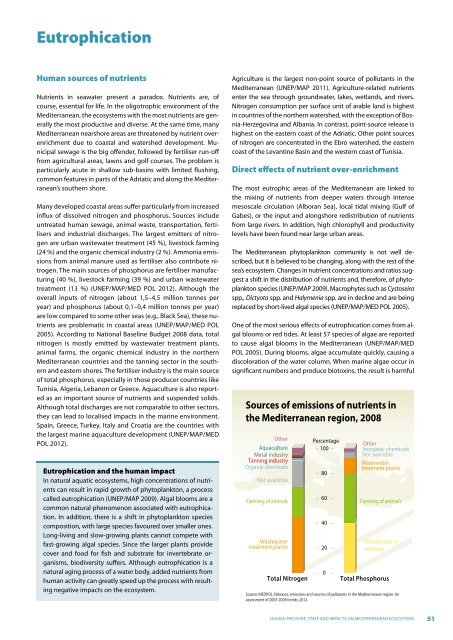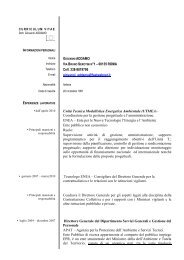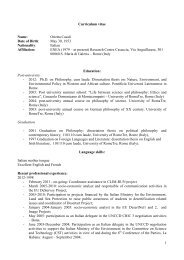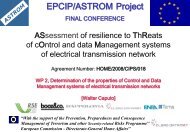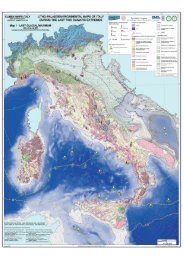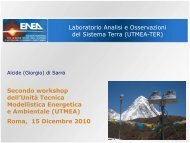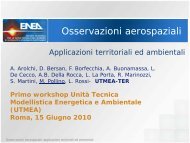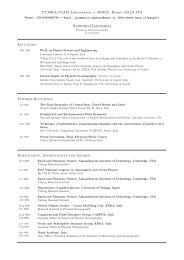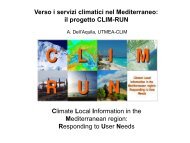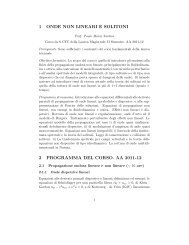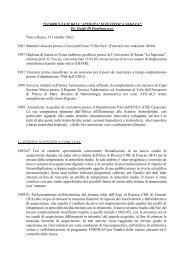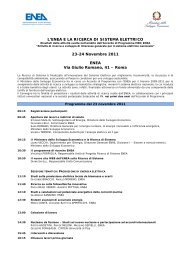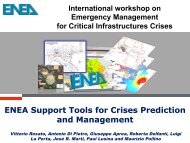State of the Mediterranean Marine and Coastal Environment
State of the Mediterranean Marine and Coastal Environment
State of the Mediterranean Marine and Coastal Environment
You also want an ePaper? Increase the reach of your titles
YUMPU automatically turns print PDFs into web optimized ePapers that Google loves.
Eutrophication<br />
Human sources <strong>of</strong> nutrients<br />
Nutrients in seawater present a paradox. Nutrients are, <strong>of</strong><br />
course, essential for life. In <strong>the</strong> oligotrophic environment <strong>of</strong> <strong>the</strong><br />
<strong>Mediterranean</strong>, <strong>the</strong> ecosystems with <strong>the</strong> most nutrients are generally<br />
<strong>the</strong> most productive <strong>and</strong> diverse. At <strong>the</strong> same time, many<br />
<strong>Mediterranean</strong> nearshore areas are threatened by nutrient overenrichment<br />
due to coastal <strong>and</strong> watershed development. Municipal<br />
sewage is <strong>the</strong> big <strong>of</strong>fender, followed by fertiliser run-<strong>of</strong>f<br />
from agricultural areas, lawns <strong>and</strong> golf courses. The problem is<br />
particularly acute in shallow sub-basins with limited flushing,<br />
common features in parts <strong>of</strong> <strong>the</strong> Adriatic <strong>and</strong> along <strong>the</strong> <strong>Mediterranean</strong>’s<br />
sou<strong>the</strong>rn shore.<br />
Many developed coastal areas suffer particularly from increased<br />
influx <strong>of</strong> dissolved nitrogen <strong>and</strong> phosphorus. Sources include<br />
untreated human sewage, animal waste, transportation, fertilisers<br />
<strong>and</strong> industrial discharges. The largest emitters <strong>of</strong> nitrogen<br />
are urban wastewater treatment (45 %), livestock farming<br />
(24 %) <strong>and</strong> <strong>the</strong> organic chemical industry (2 %). Ammonia emissions<br />
from animal manure used as fertiliser also contribute nitrogen.<br />
The main sources <strong>of</strong> phosphorus are fertiliser manufacturing<br />
(40 %), livestock farming (39 %) <strong>and</strong> urban wastewater<br />
treatment (13 %) (UNEP/MAP/MED POL 2012). Although <strong>the</strong><br />
overall inputs <strong>of</strong> nitrogen (about 1,5–4,5 million tonnes per<br />
year) <strong>and</strong> phosphorus (about 0,1–0,4 million tonnes per year)<br />
are low compared to some o<strong>the</strong>r seas (e.g., Black Sea), <strong>the</strong>se nutrients<br />
are problematic in coastal areas (UNEP/MAP/MED POL<br />
2005). According to National Baseline Budget 2008 data, total<br />
nitrogen is mostly emitted by wastewater treatment plants,<br />
animal farms, <strong>the</strong> organic chemical industry in <strong>the</strong> nor<strong>the</strong>rn<br />
<strong>Mediterranean</strong> countries <strong>and</strong> <strong>the</strong> tanning sector in <strong>the</strong> sou<strong>the</strong>rn<br />
<strong>and</strong> eastern shores. The fertiliser industry is <strong>the</strong> main source<br />
<strong>of</strong> total phosphorus, especially in those producer countries like<br />
Tunisia, Algeria, Lebanon or Greece. Aquaculture is also reported<br />
as an important source <strong>of</strong> nutrients <strong>and</strong> suspended solids.<br />
Although total discharges are not comparable to o<strong>the</strong>r sectors,<br />
<strong>the</strong>y can lead to localised impacts in <strong>the</strong> marine environment.<br />
Spain, Greece, Turkey, Italy <strong>and</strong> Croatia are <strong>the</strong> countries with<br />
<strong>the</strong> largest marine aquaculture development (UNEP/MAP/MED<br />
POL 2012).<br />
Eutrophication <strong>and</strong> <strong>the</strong> human impact<br />
In natural aquatic ecosystems, high concentrations <strong>of</strong> nutrients<br />
can result in rapid growth <strong>of</strong> phytoplankton, a process<br />
called eutrophication (UNEP/MAP 2009). Algal blooms are a<br />
common natural phenomenon associated with eutrophication.<br />
In addition, <strong>the</strong>re is a shift in phytoplankton species<br />
composition, with large species favoured over smaller ones.<br />
Long-living <strong>and</strong> slow-growing plants cannot compete with<br />
fast-growing algal species. Since <strong>the</strong> larger plants provide<br />
cover <strong>and</strong> food for fish <strong>and</strong> substrate for invertebrate organisms,<br />
biodiversity suffers. Although eutrophication is a<br />
natural aging process <strong>of</strong> a water body, added nutrients from<br />
human activity can greatly speed up <strong>the</strong> process with resulting<br />
negative impacts on <strong>the</strong> ecosystem.<br />
Agriculture is <strong>the</strong> largest non-point source <strong>of</strong> pollutants in <strong>the</strong><br />
<strong>Mediterranean</strong> (UNEP/MAP 2011). Agriculture-related nutrients<br />
enter <strong>the</strong> sea through groundwater, lakes, wetl<strong>and</strong>s, <strong>and</strong> rivers.<br />
Nitrogen consumption per surface unit <strong>of</strong> arable l<strong>and</strong> is highest<br />
in countries <strong>of</strong> <strong>the</strong> nor<strong>the</strong>rn watershed, with <strong>the</strong> exception <strong>of</strong> Bosnia-Herzegovina<br />
<strong>and</strong> Albania. In contrast, point-source release is<br />
highest on <strong>the</strong> eastern coast <strong>of</strong> <strong>the</strong> Adriatic. O<strong>the</strong>r point sources<br />
<strong>of</strong> nitrogen are concentrated in <strong>the</strong> Ebro watershed, <strong>the</strong> eastern<br />
coast <strong>of</strong> <strong>the</strong> Levantine Basin <strong>and</strong> <strong>the</strong> western coast <strong>of</strong> Tunisia.<br />
Direct effects <strong>of</strong> nutrient over-enrichment<br />
The most eutrophic areas <strong>of</strong> <strong>the</strong> <strong>Mediterranean</strong> are linked to<br />
<strong>the</strong> mixing <strong>of</strong> nutrients from deeper waters through intense<br />
mesoscale circulation (Alboran Sea), local tidal mixing (Gulf <strong>of</strong><br />
Gabes), or <strong>the</strong> input <strong>and</strong> alongshore redistribution <strong>of</strong> nutrients<br />
from large rivers. In addition, high chlorophyll <strong>and</strong> productivity<br />
levels have been found near large urban areas.<br />
The <strong>Mediterranean</strong> phytoplankton community is not well described,<br />
but it is believed to be changing, along with <strong>the</strong> rest <strong>of</strong> <strong>the</strong><br />
sea’s ecosystem. Changes in nutrient concentrations <strong>and</strong> ratios suggest<br />
a shift in <strong>the</strong> distribution <strong>of</strong> nutrients <strong>and</strong>, <strong>the</strong>refore, <strong>of</strong> phytoplankton<br />
species (UNEP/MAP 2009). Macrophytes such as Cystoseira<br />
spp., Dictyota spp. <strong>and</strong> Halymenia spp. are in decline <strong>and</strong> are being<br />
replaced by short-lived algal species (UNEP/MAP/MED POL 2005).<br />
One <strong>of</strong> <strong>the</strong> most serious effects <strong>of</strong> eutrophication comes from algal<br />
blooms or red tides. At least 57 species <strong>of</strong> algae are reported<br />
to cause algal blooms in <strong>the</strong> <strong>Mediterranean</strong> (UNEP/MAP/MED<br />
POL 2005). During blooms, algae accumulate quickly, causing a<br />
discoloration <strong>of</strong> <strong>the</strong> water column. When marine algae occur in<br />
significant numbers <strong>and</strong> produce biotoxins, <strong>the</strong> result is harmful<br />
Sources <strong>of</strong> emissions <strong>of</strong> nutrients in<br />
<strong>the</strong> <strong>Mediterranean</strong> region, 2008<br />
O<strong>the</strong>r<br />
Aquaculture<br />
Metal industry<br />
Tanning industry<br />
Organic chemicals<br />
Not available<br />
Farming <strong>of</strong> animals<br />
Wastewater<br />
treatment plants<br />
Total Nitrogen<br />
Percentage<br />
100<br />
80<br />
60<br />
40<br />
20<br />
O<strong>the</strong>r<br />
Inorganic chemicals<br />
Not available<br />
Wastewater<br />
treatment plants<br />
Farming <strong>of</strong> animals<br />
Manufacture <strong>of</strong><br />
fertilizers<br />
Total Phosphorus<br />
Source: MEDPOL; Releases, emissions <strong>and</strong> sources <strong>of</strong> pollutants in <strong>the</strong> <strong>Mediterranean</strong> region. An<br />
assessment <strong>of</strong> 2003-2008 trends; 2012.<br />
0<br />
HUMAN PRESSURE, STATE AND IMPACTS ON MEDITERRANEAN ECOSYSTEMS<br />
51


